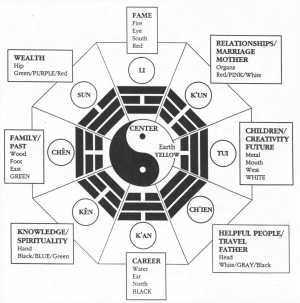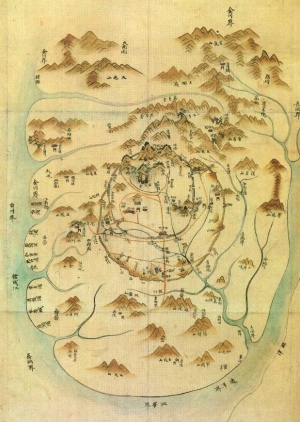By Kang Hwan-ung
Chairman, Korea Fengshui Association

Conventional Fengshui Theory
It is also believed that Fengshui is an ancient Chinese system of geomancy based on the laws of both heaven (astronomy) and earth (geography) to help people improve life by receiving positive “gi,” or “qi” in Chinese which means energy.
And it is said that the theory of Fengshui was first introduced into the Shilla Kingdom (57 BC-935 AD) from the Chinese Tang Dynasty (618-907) by Ven. Do Sun who had studied Buddhism in China, and that it flourished during the Goryeo period (918-1392) on the Korean Peninsula. The following is a story on Fengshui written by Dr. Kang Hwan-ung, chairman of Korea Fengshui Association, from the 21st century standpoint, which we hope will attract attention of modern civilization-weary people to ancient people’s wisdom of turning natural phenomena to their own advantage.-- Ed
Contending Theories
There are two contending theories about when and where the idea of Fengshui was first conceived. The first theory contends that Fengshui originated on the Korean Peninsula and the second argues that it started in ancient China and was introduced into the peninsula later. Of these two theories, the prevailing theory here in Korea is, of course, the first one.
This contention is based on two historical facts. First, geomantic ideology and practice are recorded in the mythology of Dangun, the legendary founder of Gojoseon (2333-108 BC), the first Korean kingdom on the Korean Peninsula. Second, kings of ancient Korean kingdoms, such as King Onjo, the founder of the Baekje Kingdom (18 BC – 660 AD), and King Yuri, the second king of Goguryo (37 BC-668 AD), studied geographical features of mountains when they looked for sites for their capitals.
Orthodox Theory
But regardless of the theories of the origin of Fengshui, we believe that since time immemorial, ancient residents on the Korean Peninsula must naturally have thought of how to understand and interpret “whiffs of winds” and “drops of rain” as a way to adapt to the surrounding environment. Even for wild animals, places where they can have a good night’s sleep and breed without outside interference or threat are ideal and propitious sites for their habitats. Moreover, nobody can deny that sites, where dwelling caves and dolmens were located, turned out to be the most advantageous locations from the geomantic point of view. Therefore, the prevailing orthodox theory is that there already arose Korea’s own Fengshui theory compatible with the local natural environment well before the legendary Dangun made his presence known.

Korean Pungsu
Dolmens, which mean stone tables literally, aimed to protect dead bodies buried in the ground. Dolmen, the house for the dead, is very similar to a thatch-roofed cottage, the house for the living, in terms of purpose and shape. Dolmens remind us that they were the prototype of Korea’s ancient architecture. They gave an overbearing look due to the cover stone being bigger than the stone pedestal. Likewise, with a big thatch roof, the traditional rural Korean cottage looked very stable.
Western Theory Spread to India
Western geomancy originated in ancient Greece. Around 1300 BC, the ancient Greeks began to think of four elements of nature – earth, fire, air and water. This Greek theory was spread to ancient India. Eventually, the Indian culture was introduced to China around the third century BC. During the period of Warring States in China, Zou Yan, the representative thinker of the School of Yin-Yang, combined and systematized two current theories at that time: Yin-Yang and the five elements or phases (wood, fire, earth, metal, and water). Afterwards, the principle of Wu Hang, or five elements or phases, was established and became the basic principle of the present-day Fengshui theory.
Yin-Yang Fengshui
There are two types of Fengshui – Yin (negative energy) Fengshui and Yang (positive energy) Fengshui. Characteristically, Asians, and Koreans, Chinese and Japanese in particular, have relied much on Yin Fengshui with which they check out their ancestors’ tombs to see if they are located in auspicious sites. They believe that the location of the tomb would affect the well-being of the tomb's occupant as well as the descendants. In many cases, a strong belief in Fengshui led kings in past dynasties to exhume and rebury their ancestors. This tradition has contributed in large part to people’s preference of burial over cremation in this part of the world. This, therefore, explains why there are so many tombs in Korean mountains.
Fengshui is not only for the dead, but also for the living. So there is Yang Fengshui for the living. Its basic idea is to create harmonious homes or search for the most favorable sites for palaces or villages. Basically, buildings or villages should be located with mountains behind and streams in front. When deciding the best direction for the house to face, it is necessary to consider the year the occupant of the house was born in to check out harmony between him or her and the five Fengshui elements.
The height and brightness of the house should be at appropriate levels. The door to the kitchen should not face the main gate of the house. All these considerations were given for the wellbeing of the occupants of the house. These Fengshui principles also apply to bedrooms and the location of each piece of furniture to create harmony in the bedroom. The Yang Fengshui is aimed at helping people love their environment as part of their lives or rearrange their furniture and accessories to change the flow of energy in their homes. After all, Yang Fengshui is for the living and the conception of a harmonious environment.
Dolmens were burial sites for ancient people. Those found on the peninsula, which date back to 3,000 to 5,000 years, are of a very unique structure that cannot be found anywhere else, either in China or in Japan. Looking at the areas surrounding the Korean dolmens, you can see how well the ancient people took advantage of their own Fengshui principles. Their dolmens are located with mountains placed behind and streams in front, according to fundamental geomantic principles.“Pungsu,” or “Fengshui” in Chinese, or simply “wind” and “water,” has been practiced for thousands of years. It has been widely believed that the idea of Fengshui was first conceived during the late period of Warring States in China (476-221 BC) when sages began to believe that changes in natural phenomena, including winds and rains, affect human society and health.


